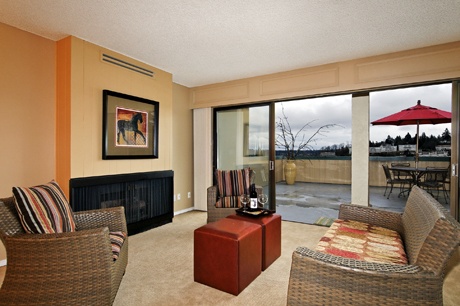Make no mistake: staging your home for sale is not decorating. Decorating is personal; it is an expression of individual style. Staging is almost the opposite. According to Wikipedia, “Home staging is the act of preparing a private residence for sale in the real estate marketplace. The goal is to make a home appealing to the highest number of potential buyers … by transforming it into a welcoming, attractive product that anyone might want.”
Whether you’re selling a one-bedroom condo or a five-bedroom waterfront home, the basic principles are the same. It’s all about showing spaces in their best possible light.
In the Island condo shown, the layout is appealing with a fabulous, large deck. However, the furniture layout blocked the room’s flow and the carpet and paint were a little tired. The brass trim on the fireplace made it look dated.
A combination of borrowed, rented and the owner’s own furniture was rearranged to open up the spaces. An outdoor dining table with a big, red umbrella leads your eye outdoors to highlight the expansive deck — a really attractive amenity in a condo that needs to be showcased. New paint, carpet and painted out fireplace trim gave the spaces new life.
The other example is a stunning new construction on the water. Even with exquisite finishes such as natural stone, hardwood floors, custom light fixtures and glass tile, the spaces needed some defining for potential dwellers. While the rooms looked beautiful vacant, buyers need suggestions as to furniture placement, size of furniture the rooms can handle, and want to experience the feeling of home.
In the family room, sofas were placed to take advantage of the fireplace and flat screen television focal points. The grand piano-sized living room showed best with seating arranged on either side of the fireplace, leaving the walkway between the living area and staircase open. Beautiful built-in bookcases on either side of the fireplace were important features to highlight.
Both of these properties are examples of staging, but for different reasons. The condo needed furniture “staging” but also updating to make it attractive to buyers. The new construction home was sparkling, but just needed to illustrate use of the spaces. The following are guidelines for staging any property:
Make sure it is clean! This means deep cleaning, and staging expert Barb Schartz refers to it as “detailing.”
“You would detail your car if you were going to sell it,” she is famous for saying. “You should detail your house, too.” Clean baseboards, wipe light switch plates, and power wash the driveway. You can’t expect potential buyers to look past these details without wanting a price discount.
Clear clutter! All of us have a lot more clutter in our homes than we think we do. In fact, most of us no longer even see it. Real Estate Professional Joan Bayley tells her clients that “clutter eats equity.” She advises moving out all clutter and overscale pieces, so buyers can actually see the house. Many staging professionals suggest following “the basketball rule,” which is removing items smaller than a basketball and packing them away. If you’re planning a move, you will have to do this anyway, so why not do it now?
Select a focal point that best highlights the features of a room, and arrange furniture to take advantage of that. The focal point may be a fireplace in a living room, a television in a family room, or a view in a bedroom. Keep in mind that you want to make rooms feel open and spacious, so pay attention to positive and negative spaces. Simply put, positive spaces are where you have something; negative spaces are left empty. People often feel the need to fill every little corner, which just adds to creating a feeling of clutter.
Many staging professionals advocate clearing all personal effects such as framed photos, and having all walls painted in neutral colors. Personally, I think a few well-chosen photographs add a touch of warmth and current, and earthy paint colors can work wonders for updating rooms. Benjamin Moore and Devine Paints both have fabulous sampling systems to get the color right the first time.
Staging furniture, art and accessories can be property of the homeowner, rented on and make great tabletop décor. Half Price Books sells something they call “books by the yard,” which is a box of older hardback books without the paper jackets for $17.50 per box. (Books by the yard refers to the three-foot height of books in the box if stacked individually.) Alternating their placement, lining a few up vertically and stacking others horizontally creates visual interest.
First impressions are critical, and it is said that buyers start making their decision within minutes of entering a home. The entrance sets the stage, so it must be welcoming. You can do that by creating a vignette with a narrow table, flowers and a picture or mirror. Mirrors are especially good because they reflect light and make spaces seem larger.
The final touches? Soft music, pleasant smells and toilet lids down. (The old adage is, “If you can smell it, you can’t sell it!”)
“Staging is a must today,” says realtor Bayley. “We can’t control the market, but we can control the condition of our homes. The investment made in staging will always be a lot less than your first price reduction.”
Note: Both residences are currently available for sale.
Lori Matzke Ehrig is a freelance interior design writer and can be reached at (206) 271-5550 or dlehrig@msn.com.




